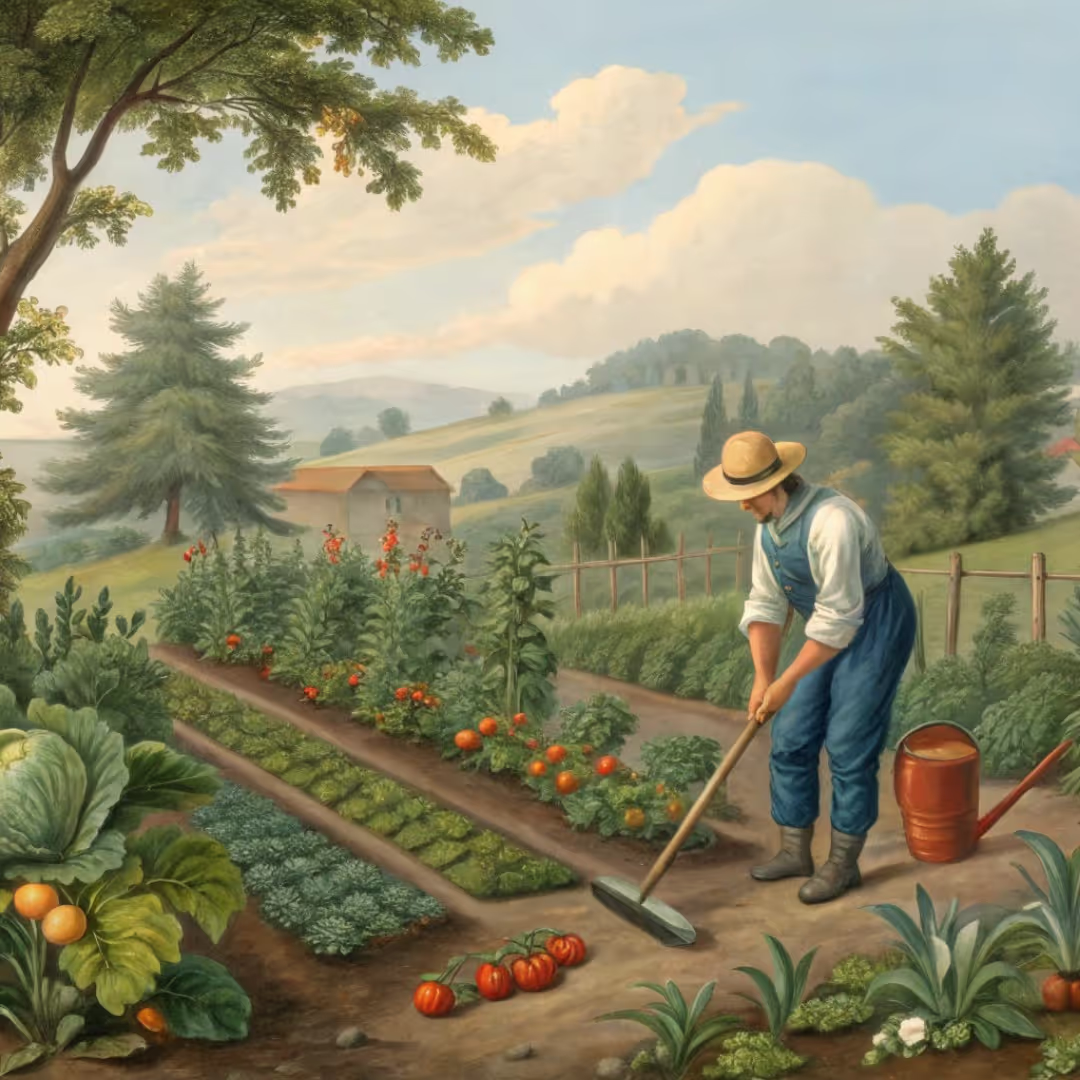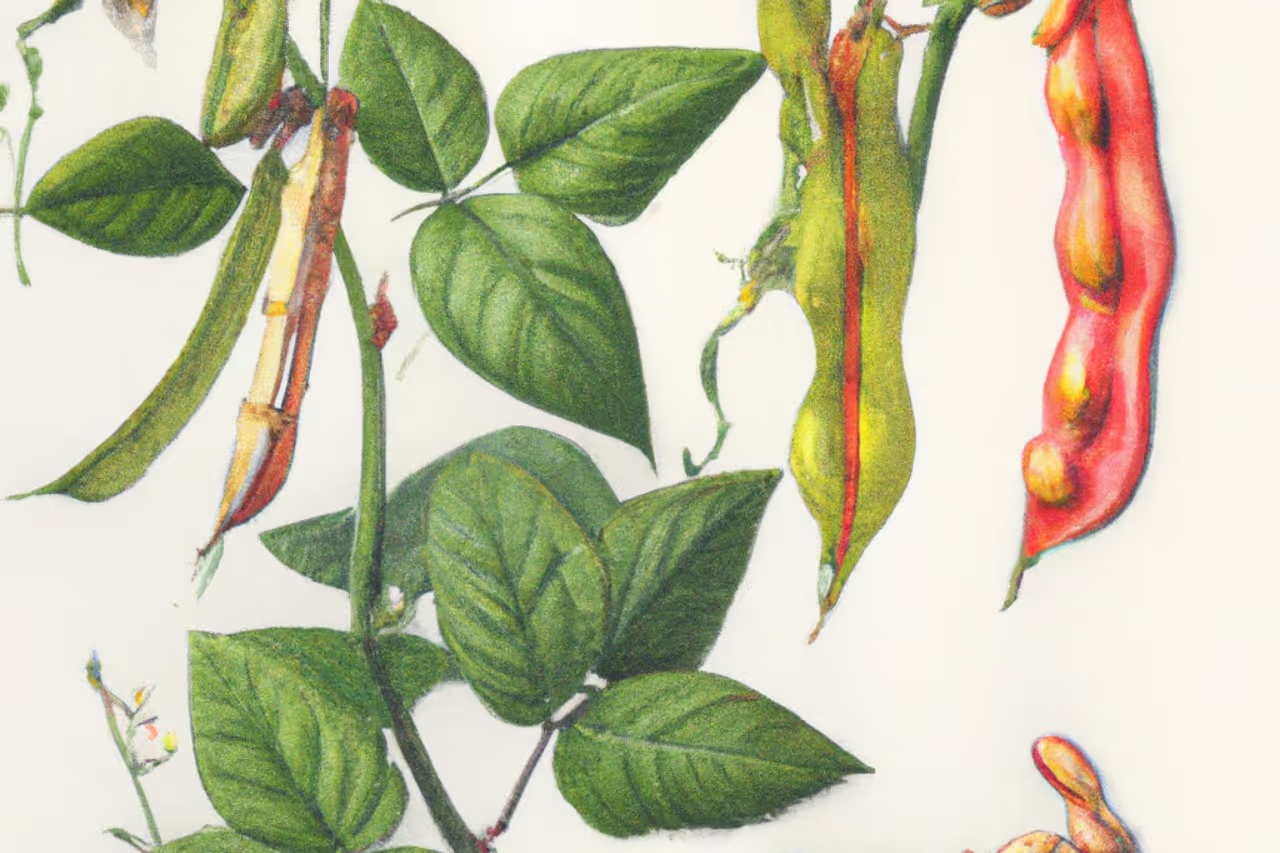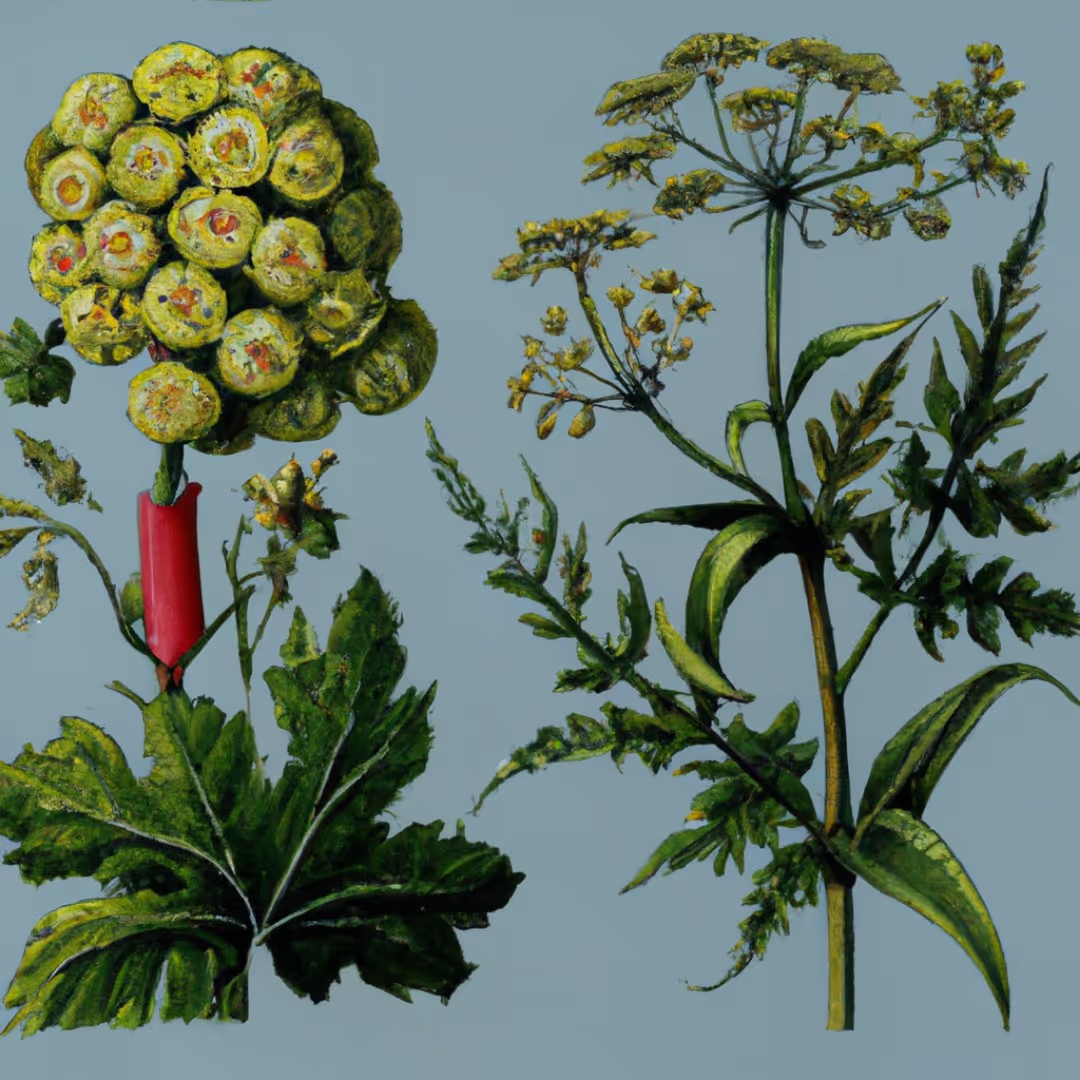How to Grow Vegetables

Vegetables
Vegetables thrive with 6–8 hours of sun, pH 6.0–7.0 soil, and 1 inch of weekly water. Start Vegetables in loosened, compost-rich beds; space tomatoes 18–24 in, lettuce 8–10 in, carrots 2 in. Mulch Vegetables 2 inches to hold moisture, feed a balanced 5-5-5 monthly, and rotate beds yearly to curb disease.
Stick around—I’ll show you the moves that turn backyard dirt into flavor.
Cheatsheet: Vegetable Growing Fast-Track
🌱 Choose the Right Site
- Sun: Minimum 6-8h full sun
- Soil: Loose, fertile, drains well
- pH: 6.0–7.0
🥕 Choose Productive Crops
- Lettuce, radish: Harvest in 30 days
- Tomato, pepper, bean: High nutrition
- 1m² feeds 1 adult salad/greens daily in summer
🛠️ Tools and Products You'll Need
- Spade, trowel, hoe
- Watering can or hose
- Compost, seeds/seedlings
- Mulch (straw, wood chips)
- Row markers
- Fertilizer, gloves
📅 Timing & Sowing
- Direct sow hardy crops when soil is 50°F/10°C
- Transplant warm crops at 60°F/15°C soil
- Stagger sowing every 2 weeks for steady harvest
🌧️ Water & Feed
- Water: 1" (2.5cm) weekly, morning best
- Feed: Use compost or balanced fertilizer monthly
🪱 Care & Harvest
- Weed weekly
- Mulch to retain moisture, suppress weeds
- Check for pests: handpick, use barriers or natural sprays
- Harvest early for best flavor, use clean tools
🍲 Health, Nutrition, Self-Sufficiency
- Homegrown = up to 3x more nutrients than store-bought
- Grow 8+ types for year-round vitamins, fiber, minerals
- Reduces grocery bills, minimizes food miles
Vegetables thrive on timing, soil, and steady care
I grow for flavor first, yield second, and sanity always. Vegetables reward the gardener who feeds the soil, watches the weather, and plants with a plan.
Sun, site, and soil pH
Pick a spot with 6 to 8 hours of sun and decent air flow, since wet leaves invite disease. Most vegetables prefer pH 6.0 to 7.0, a range backed by Cornell Cooperative Extension, so I test yearly and tweak with lime or sulfur slowly.
I layer 2 to 3 inches, 5 to 7.5 cm, of compost every season to feed microbes and buffer pH. The soil becomes loose, crumbly, and forgiving, and my carrots pull clean without a fight.
Raised beds vs in-ground vs containers
Raised beds warm up faster in spring, drain well, and simplify intensive spacing. In-ground rows shine on big plots with cover crops, while containers win on patios if you use a peat-free, compost-rich mix and a pot at least 10 gallons, 38 liters, for tomatoes.
I edge beds with wood or recycled plastic, 8 to 12 inches tall, 20 to 30 cm, and keep aisles wide enough to weed without trampling roots. It feels like a small kitchen line that actually runs on time.
Plan by season and frost dates
I sort vegetables into cool crops and warm crops, then work backward from frost dates. NOAA frost probability tables plus the USDA Zone Map steer my timing, and a simple spreadsheet keeps me honest.
Cool crops like lettuce and peas go in when soil hits 40 to 50 F, 4 to 10 C. Warm lovers like tomatoes wait for 60 F, 16 C, soil and nights above 50 F, 10 C, or they sulk.
Succession planting for constant harvests
I seed lettuce every 10 to 14 days, sow bush beans monthly, and replant carrots as soon as a row clears. Short-season varieties keep the conveyor belt moving without gaps.
Staggered plantings outpace pests, dodge heat waves, and spread labor. It also scratches that gambler itch without wrecking the season.
Seeds, starts, and seed starting
I start tomatoes 6 to 8 weeks before the last frost, peppers and eggplants 8 to 10, and brassicas 4 to 6. Peppers germinate best near 80 F, 27 C, and a heat mat pays for itself in one happy tray.
Seedlings need 14 to 16 hours of bright light with PPFD around 200 to 400 for stocky growth. Full-spectrum LED at 5000 to 6500 K set 6 to 8 inches, 15 to 20 cm, above the canopy works, then raise lights as plants grow.
Hardening off and transplant day
I move trays outside for 7 to 10 days, increasing exposure daily, so wind and sun toughen the cuticle. Transplant on a cloudy afternoon, water deeply, and firm the soil so roots make contact.
Tomatoes get planted deep to the first true leaves for extra rooting. I keep peppers at the same soil line to avoid stem rot learned the hard way in a wet spring.
Water, drip irrigation, and mulch
Consistent soil moisture beats feast and famine. EPA WaterSense notes that drip can cut water use by roughly 30 to 50 percent compared with overhead, and my disease pressure dropped once I switched.
A 2 to 3 inch, 5 to 7.5 cm, layer of mulch like shredded leaves cools soil, limits weeds, and stretches every gallon, 3.8 liters. I water early morning, aim for 1 inch, 2.5 cm, per week, and push more in heat waves.
Feeding vegetables without overdoing it
Read the label and learn NPK: nitrogen for leafy growth, phosphorus for roots and flowers, potassium for vigor and stress response. I side-dress heavy feeders like corn and tomatoes with compost or an OMRI Listed organic fertilizer at flowering.
Soil biology does the heavy lifting, so I avoid salt-heavy quick fixes that burn roots. If leaves pale midseason, a light fish or seaweed foliar spray can tide things over.
Spacing, trellising, and airflow
Overcrowding breeds mildew and small fruit. I give indeterminate tomatoes 18 to 24 inches, 45 to 60 cm, on a single or double leader, and I prune to one or two stems for ventilation.
Cucumbers climb well on a cattle panel or 150 mm netting, which keeps fruit straight and clean. Pole beans scale twine like acrobats, freeing ground for lettuce underneath.
Pests, disease, and IPM
I scout twice weekly, since early action beats panic sprays. Row cover, 0.5 oz per sq yd, 17 gsm, blocks flea beetles and cabbage moths, and I remove it at flowering for pollination.
If thresholds are exceeded, I choose targeted products first. Bt for caterpillars, spinosad for thrips and leaf miners, insecticidal soap for aphids, always following the label.
Rotation breaks disease cycles, so I move plant families every 3 to 4 years. Resistant codes help too, like tomatoes labeled VFN for verticillium, fusarium, and nematodes.
“Only 1 in 10 adults meets vegetable intake recommendations in the United States” (CDC).
Weeding without losing weekends
I hoe shallowly before weeds hit the two-leaf stage, which saves hours later. Mulch and tight planting close the canopy and starve stragglers of light.
Harvest and handling
I pick in the cool morning, then dunk greens in cold water, 34 to 40 F, 1 to 4 C, to crisp them up. Tomatoes stay off the fridge, since cold ruins texture and dulls aroma.
For sweetness I let melons drop easily from the vine and watch the ground spot turn buttery. I clip herbs before flowering for the boldest flavor.
“An average food garden can return hundreds of dollars in produce value per season on a modest investment” (National Gardening Association).
Best vegetables for first-time success
- Leaf lettuce and salad mixes, fast, forgiving, steady.
- Bush beans, high yield per square foot with little fuss.
- Cherry tomatoes, less splitting, constant fruiting, big morale boost.
- Radishes, 25 to 35 days and they teach spacing discipline.
- Zucchini, plant two to spread risk, pick small for tenderness.
- Garlic, plant in fall, harvest in summer, outrageous aroma.
High value vegetables per square foot
- Herbs like basil, cilantro, and chives, premium flavor, tiny footprint.
- Cherry tomatoes on trellis, long season, heavy set.
- Salad greens successions, constant turnover, premium price at markets.
- Specialty peppers like shishito and jalapeño, compact plants, steady yield.
Heat-tough vegetables and tactics
- Malabar spinach and New Zealand spinach for summer greens that do not bolt in heat.
- Sweet potatoes and okra for hot, humid beds that fry lettuce by breakfast.
- Shade cloth at 30 percent over lettuce keeps tips from scorching above 90 F, 32 C.
Vegetables for partial shade
- Leafy greens, Asian greens, and arugula at 4 to 5 hours of sun.
- Beets and carrots for roots in dappled light with a longer timeline.
- Mint and parsley, harvest often so they do not sprawl.
Containers that really produce
- Determinate tomatoes like ‘Roma’ or ‘Bush Early Girl’ in 10 to 15 gallon, 38 to 57 liter, pots with cages.
- Peppers in 7 to 10 gallon, 26 to 38 liter, pots, which warm fast and fruit early.
- Cucumbers on a balcony trellis with a 15 gallon, 57 liter, tub and frequent watering.
Season extension that actually works
Low tunnels with wire hoops and 0.9 to 1.0 oz per sq yd, 30 to 34 gsm, fabric can buy you 4 to 6 F, 2 to 3 C, on frosty nights. In spring I double up with clear plastic over fabric then vent daily to prevent cooking seedlings.
Cold frames facing south stack early salads before the neighbors stir. In fall they carry spinach well past the first hard frost.
Soil testing and small corrections
A lab test once a year beats guessing. If organic matter stalls below 5 percent, I grow a winter cover crop like cereal rye and hairy vetch, then mow and compost in place.
Micronutrients matter in tired soils, so I fix boron and zinc only after a test flags them. Overapplication solves nothing and can lock out other elements.
Smart shopping for gear and inputs
- Soil test kits or lab services that report pH, OM percentage, and NPK recommendations in lbs per 100 sq ft and kg per 10 m².
- LED grow lights with stated PPFD maps, 5000 to 6500 K spectrum, and dimming to prevent leggy starts.
- Drip kits with pressure regulation, 0.5 to 1 gph emitters, 1.9 to 3.8 lph, and a simple filter you can clean without tools.
- Fertilizers with a clear analysis and, if organic, an OMRI Listed label for transparency.
- Row cover by weight and purpose, lighter for insects, heavier for frost, and enough clips to stop wind from chewing it up.
- Seed trays at 72 cells for most starts and soil blocks for air pruning if you like transplant roots that burst on planting.
Companion planting that earns its keep
I intercrop basil with tomatoes to shade soil and keep humidity lower, which helps with leaf spot. Dill and cilantro flower early and pull in hoverflies that shred aphids for free.
Marigolds help with nematode issues in sandy beds, but I treat them as a rotation tool rather than a magic bullet. The real work is good sanitation, airflow, and time.
Notes from the field
I have had flea beetles turn eggplant leaves into lace in two days, which row cover stopped cold. I once chased powdery mildew across a zucchini patch until I cut out the worst leaves, fed the roots, and opened the canopy to sun, then the plants roared back.
On a tomato trial I noticed flavor tracks stress in a crooked way. Slightly lean watering bumped aroma and sweetness in cherries, measured by higher Brix on a handheld refractometer, but too dry triggered blossom-end rot overnight.
Trusted references I lean on
- USDA Plant Hardiness Zone Map for planning and variety choice.
- NOAA frost and freeze probabilities for last and first frost windows.
- Cornell Cooperative Extension vegetable guidelines for pH, spacing, and disease management.
- EPA WaterSense for irrigation efficiency comparisons.
- Royal Horticultural Society advice on mulching, watering timing, and nonchemical controls.
- CDC reports on vegetable intake patterns that remind me to plant another bed of greens.
Tomato clinic, quick hits
- Night temps for fruit set sit best between 55 and 70 F, 13 to 21 C.
- Calcium issues show as blossom-end rot, which ties to uneven watering more than a lack of calcium in the soil.
- Blight loves wet leaves, so prune for airflow and keep irrigation at the soil line.
Brassica playbook
- Plant early spring or late summer to miss peak cabbage moth flights.
- Use lightweight row cover from day one and remove only to weed and thin.
- Feed modestly, since too much nitrogen draws aphids like a dinner bell.
Reality check and reward
Vegetables can turn a small patch into a kitchen you can walk through in bare feet. On a good August afternoon the garden smells like a tomato sandwich before you even pick the bread.
Frequently Asked Questions About Growing Vegetables
What soil type works best for vegetables?
Most vegetables thrive in well-draining, nutrient-rich soil, typically a loamy mixture containing organic matter like compost or well-rotted manure. Aim for a pH level between 6.0 and 7.0 to keep plants healthy and productive.
How much sunlight do vegetable plants need?
For optimal growth, most vegetable crops require at least 6 to 8 hours of direct sunlight daily. Leafy greens tolerate partial shade, while fruiting vegetables such as tomatoes and peppers prefer full sun exposure.
How frequently should I water my vegetable garden?
Regular watering is key—most vegetables benefit from about 1 inch (2.5 cm) of water per week. Water deeply, encouraging roots to develop downward, and adjust frequency depending on weather conditions, rainfall, and soil moisture.
What vegetables are ideal for beginner gardeners?
Easy-to-grow vegetables include radishes, lettuce, zucchini, carrots, and bush beans. Selecting these varieties ensures a successful first season with manageable maintenance and quick results.
When is the best time to plant vegetables?
Timing depends on your local climate. Cool-season vegetables such as peas, spinach, and broccoli are planted early in spring (soil temperature around 40–60°F / 4–16°C). Warm-season vegetables like tomatoes, peppers, and cucumbers prefer planting after frost risk passes and soil warms above 60°F (16°C).
How can I protect my vegetable plants from pests organically?
Encourage beneficial insects such as ladybugs and praying mantises by planting companion herbs and flowers. Regularly inspect plants, handpick pests, and use natural deterrents like neem oil, diatomaceous earth, and insecticidal soap to minimize pest damage organically.
What nutrients do vegetables require to thrive?
Vegetable plants depend primarily on three nutrients: nitrogen (N), phosphorus (P), and potassium (K). Nitrogen promotes leafy growth, phosphorus supports root development, and potassium strengthens overall plant vigor. Regular soil tests help determine specific nutrient needs and adjustments.
Growing Vegetables rewards steady work and a calm eye. Start with living soil fed by compost. Choose a spot with 6 to 8 hours of sun. Water deep and on schedule, then let roots breathe. Lay down mulch to steady moisture and block weeds. Give plants room so leaves dry quick.
Scout weekly. Knock back weeds while small. Hand-pick pests, use row cover, welcome pollinators. Rotate families each season and sow in small waves for succession. Mix quick crops with anchors like tomatoes. Feed lightly, then watch. Harvest in the cool morning for snap and aroma. Keep notes, save seed, and compost every scrap. Do these simple things and your vegetables will taste like they should.







